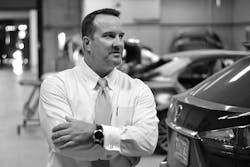At Brian Martin’s two high-volume shops, everything counts—especially when it comes to paint and materials.
As director of auto collision for Lexus of Pembroke Pines and Lexus of North Miami (Florida), he sees about 500 cars per month across both body shops. But with such high volumes, he noticed that his paint and materials (P&M) profits could be tracked a little better.
And with a push from insurance companies to reduce paint times on estimates, he knew he needed a better system to combat falling victim to not being compensated appropriately for his shops’ work.
After some critical tracking and standing his ground with insurers, Martin excelled in the P&M department. Here’s how he did it.
The Backstory
Martin has been with Craig Zinn Automotive Group for 11 years. He designed, engineered and built the body shop for Lexus of North Miami.
But despite the major strides the shops have made, there was once a time when Martin noticed that his P&M profits could be improved, as his operation consistently sat in the low- to mid-40 percent range.
His company brought in Mike Anderson, president of Collision Advice, and joined his Axalta 20 Group to identify ways to increase those profits.
The Problem
“There were a lot of initial obstacles,” Martin says about beginning the journey to increased P&M profits. And it all started with dealing with the DRPs.
According to Martin, South Florida has some of the lowest labor rates in the country and low allotments for P&M work, which he realized when he started going to 20 Groups and learning about other shops.
And when insurance companies decided to reduce the paint times on repair panels, he says it was a huge eye opener and a huge profit decline. After being told time and time again by insurance companies to either comply or lose the DRP, Martin eventually opted to eliminate the partnership.
“[After losing the DRP], we lost some volume, but in the end we certainly made that up in profit,” he says. “We really have to focus on what we’re collecting from the insurance company as far as paint and material sales per repair order.”
Once he addressed the concerns with the insurance companies, he began reviewing his internal operations and realized there were a number of issues:
Balancing the paint increase: Martin says that there is a constant yearly increase in paint costs. The manufacturers triple, if not, quadruple the pace of additional income for paint and materials allotted by the insurance company, so it’s essential that they balance the costs.
Reduction in paint times: He wasn’t fighting against the reduction of paint times on estimates.
Maximizing estimates: Shop employees weren’t sure if they were charging appropriately for all the simple things, like a two-color setup or blending.
Measuring: The shop did not effectively measure each painter’s usage or identify overpouring problems.
The Solution
First, the shops made it a standing practice that they were never going to allow paint reductions unless it can be proven otherwise by an insurance company, Martin says.
Because manufacturers provide paint times to estimating softwares such as CCC, insurance companies will manually reduce the times with an argument such as, for example, since only a portion of a panel is being painted, the entire time allotted is not needed, according to Martin. This reduces labor revenue and the allotment for paint and materials based on paint labor time.
“We, under no circumstance, allow for a paint cap,” he says.
He says that a lot of the time, they have to educate insurance companies as to why the processes don’t change when repairing a panel and why the reduction in times don’t work. And when he asks them why they chose the amount they did, he says “99 percent of the time,” they can’t substantiate the answer.
“When we pushed back and held our line, they came back,” he says.
Next, Martin evaluated the estimates. He realized that the biggest and easiest way to increase P&M profitability was through the selling and estimating process.
Since flex additive isn’t included in the Axalta paint line and there is a high volume of cars that require the additive on bumper work, Martin concluded he needed to charge for it.
“We really have to make sure that if we’re doing it, we’re getting paid for it,” he says. “With one of our DRPs, we’ve been advised that we’re the only ones in the state of Florida that charges for flex additive.”
If for any reason the shops have a low P&M profit month, Martin says that his team prints a detailed list of all the repairs orders for the month and calculates what went wrong by asking the following questions:
-
Did we have any paint caps?
-
Did we have a low paint and material per estimate?
-
Was it a certain estimator?
-
Was it an estimator that wasn’t trained properly?
-
Did we have re-dos from a certain paint technician?
-
Did we have any waste?
-
Has our hazardous waste removal gone up?
In addition to the shop’s management system, he began tracking the each paint technician’s usage per hour through Axalta’s paint scale.
“One of the things that made a big difference to us was measuring all of the products across the scale,” he says.
Every painter has to enter their repair order on the mixing scale and mix across the scale. This way, he can assess if it’s the same tech that consistently has low profits, if more education is needed, etc.
The shop also uses Nuventory, which is a software that allows Martin to calculate the cost per hour per tech for dry goods.
“It’s more to let us know what we’re using and what we’re ordering and that’s something that has been extremely cost efficient for us,” he says. “In fact, it lowered our dry goods by half.”
The Aftermath
Now, the shop is consistently in the 55–65 percent range for P&M profits across both shops, a more than 10 percent jump from his profit margins in 2012.
Martin says that because the estimates are being done correctly and reflect the proper paint times, it has helped tremendously with the technicians’ morale,
This led to improved efficiency. All techs across both locations are above 150 percent efficiency, a 15–20 percent jump from where the techs were before the P&M changes in 2012.
The Takeaway
From this experience, Martin has realized his top five tips for any shop looking to increase P&M profits:
-
Focus on each and every estimate.
-
Focus on not accepting a paint cap.
-
Focus on not having reduced paint times or blend within panels, even if it is with a DRP.
-
Understand what it takes to fix the cars back to manufacturers’ standards.
-
Join the 20 Group of your paint manufacturer.
SHOP STATS: LEXUS OF PEMBROKE PINES Location: PEMBROKE PINES, FL. Average Monthly Car Count: 275 Staff Size: 60 (8 Painters) Shop Size: 35,000 sq ft; Annual Revenue;$12 Million
SHOP STATS: LEXUS OF NORTH MIAMI Location: MIAMI, FL. Average Monthly Car Count: 215-225 Staff Size: 50 (6 Painters) Shop Size: 45,000 sq ft; Annual Revenue;$10 Million
Expert Advice
—
Brent Beaulieu, national account manager for Axalta Coating Systems, has helped many of his clients time and time again with their P&M profits.
Having been in the industry for over 20 years, working in body shops and eventually transitioning into his current role, Beaulieu offers some tips for achieving and maintaining high P&M profits.
Tips for Easy Implementation
Standardize the materials: Whether you’re an independent shop or an MSO, most tend to allow their techs to buy all types of materials from different brands. That makes it hard to track your usage.
Separate your accounts: Having a breakdown of your distributor accounts, such as taxable and non-taxable, makes it easier to determine the best area for your accounts.
Understand both sides: There are two sides to P&M gross profit: the cost side (which is what the body shop purchases) and then the sales side (which body shops collect on estimates). If you spend more than what you’re bringing in in sales, that’s obviously bad because you’ll have a negative gross profit. You need to make sure that you’re capturing sales from estimates.
Spot check the estimates: Have your estimator spot check other estimates. If you have peers spot checking, you can capture additional material sales.
Tips to Achieve and Maintain Improved Profits
Consistency. Continue to monitor and operate your processes in place.
Standardize materials (see above).
Limit your suppliers. Limit your suppliers to preferably one. Most shops search for the best deal, so they buy from multiple distributors. This makes it tough to keep up and you suddenly become blinded by the “best deal.”
Check in. Check on your suppliers’ pricing every six months to ensure consistency.

